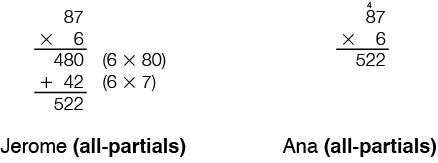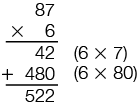Yellow
Green
Blue
Red
Magenta
Remove
Mrs. Dewey said, “Who can show us other paper-and-pencil ways to multiply?” Again, many hands went up. Mrs. Dewey wrote 87 6 on the board. Jerome said he could solve the problem using the all-partials method. Ana said she could solve it using the compact method.
Here is Jerome's and Ana's work.

- Why did Jerome multiply 6 80 instead of 6 8? How is the all-partials method like the expanded-form method?
- Why did Ana write a small 4 above the 8 when using the compact method? How did she use the 4 to get her final answer?
- Solve these problems in two ways. Use the all-partials and compact methods.
- 93 6
- 67 4
- 7 42
Tanya noticed that when using the all-partials method, Jerome started by multiplying 6 times the tens, then 6 times the ones in 87. She wondered if the order mattered. Tanya tested her idea. She solved the problem this way:

- What did Tanya discover about the order for this problem?
- Solve Question 8C using the all-partials method in a different order. Does the order matter?
Fill in the missing numbers in the multiplication problems below. Make sure you can explain what to multiply to get each partial product.














